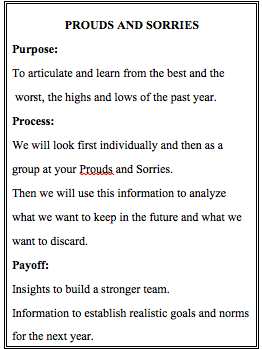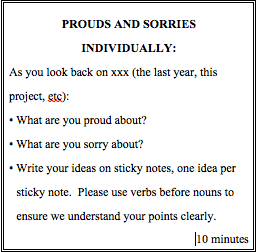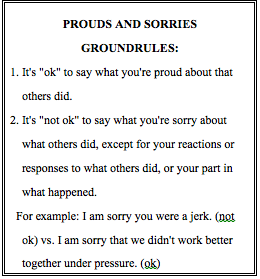“Our group has been through a lot together and we’ve developed some serious emotional energy about how we worked with each other in the past. It’s difficult to articulate exactly what all the issues are, but I want to use this energy and past experience to help us in the future. What do you suggest?”
#13 Prouds and Sorries
What are Prouds and Sorries?
The Prouds and Sorries technique constructively addresses both the positive and potentially negative emotional issues facing your meeting group. Because emotional issues can heavily impact the effectiveness of any group, it is imperative for you to have a technique in your arsenal to help effectively deal with these types of problems. Overlooking these emotional issues or pretending that they don’t exist can be disastrous.
Conveying Prouds and Sorries helps a group come to terms with its past. The technique analyzes, in a methodical way, what the group’s participants feel proud about and what they feel sorry about. This information is used to clear the air as well as initiate discussions to establish norms, goals and objectives for the future.
Emotional energy is common within work groups. It is especially strong in organizations that are downsizing and going through dramatic change, in groups where a project has ended negatively, and in organizations that have been purchased or taken over by another group. Prouds and Sorries allows people to own up and move on.
When to Use Prouds and Sorries
- When you want to reflect on the past in order to make the future even better
- When there are many hard feelings amongst a group
- When you want to allow people to share feelings about a project in a constructive, focused manner
- When you want to use the past to build on the future
How to Use Prouds and Sorries
Before the Meeting
- Assemble the necessary materials: enough sticky notes, marking pens, and chart paper to bring to the meeting.
- Create the charts you will use. (See the figures below for examples.)
During the Meeting
1. Explain the purpose of the exercise and introduce the Prouds and Sorries technique. Consider using a Three P Statement as illustrated below.
2. Ask the group to answer these questions, “What are you proud about?” and “What are you sorry about?” Display these questions on a chart similar to the one below.
Then explain the groundrules for answering the questions you have posed, exhibiting a Prouds and Sorries groundrules chart. An example of this chart is illustrated below.
NOTE: Unless you are an outside facilitator, remember to write your own Prouds and Sorries too. If you think you will be too rushed to do them during the meeting and facilitate the meeting as well, write them down ahead of time.
3. When everyone is finished, ask the participants to bring their ideas forward and attach them to the appropriate charts you have pre-labeled Prouds and Sorries.
4. Ask the group to cluster their ideas with similar ideas. Split the group in two, one to cluster Prouds, and one to cluster the Sorries. Allow ten to fifteen minutes for clustering. Ask the two groups to put a heading on each cluster.
OPTION: If your group has more than twenty people, consider asking for volunteers to cluster the information when the rest of the group takes a short break.
5. When the Prouds and Sorries are clustered and have headings, ask representatives from each group to read aloud all the information in the categories they created.
6. Debrief Prouds and Sorries. You might ask the group, for example, “As you listened to the other groups, what common threads did you hear? What in particular stood out for you? What can we learn from this information?”
OPTION: Ask your group to create a priority list of the proudest Prouds, and the sorriest Sorries. This list would be used to summarize the feelings of the group, and is especially helpful with large groups or groups with long lists of Prouds and Sorries.
7. Use this information to establish norms, goals and objectives for the future.
In Summary:
The Prouds and Sorries technique can help a group articulate both their positive and negative feelings about events that happened in the past.
Before the Meeting
1. Assemble enough sticky notes, marking pens, and chart paper.
2. Create the charts you will use.
During the Meeting
1. Explain the purpose of the exercise and introduce the Prouds and Sorries technique.
2. Ask the group write their responses to “What are you proud about?” and “What are you sorry about?” on the topic under consideration. Set groundrules for the exercise.
3. Ask the group to bring their ideas forward and place on the appropriate charts labeled Prouds and Sorries.
4. Split the group in two and ask them to cluster their ideas with similar ideas, one group for Prouds and one group for Sorries.
5. After clustering and giving each cluster a heading, ask participants to read the responses in the categories they created.
6. Debrief the information with the goal of learning from the experience.
7. Use this information to establish norms, goals, and objectives for the future.
Source: Marvin Weisbord, Discovering Common Ground, San Francisco: Berrett-Koehler Publishers, 1992.
———————-
NOTE: If you would like to receive e-mail notification when I post additional techniques, please sign up through this link. http://eepurl.com/KILan You may unsubscribe at any time.


